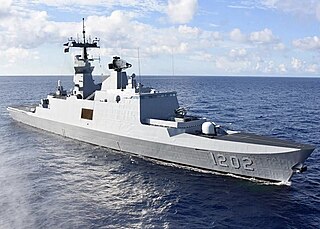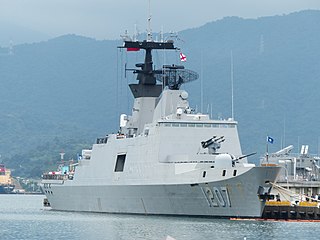
The 46 Knox-class frigates were the largest, last, and most numerous of the US Navy's second-generation anti-submarine warfare (ASW) escorts. Originally laid down as ocean escorts, they were all redesignated as frigates on 30 June 1975, in the 1975 ship reclassification plan and their hull designation changed from 'DE' to 'FF'. The Knox class was the Navy's last destroyer-type design with a steam turbine powerplant.

The La Fayette class is a class of general purpose frigates built by DCNS in the 1980s/90s and still operated by the French Navy today. Derivatives of the type are in service in the navies of Saudi Arabia, Singapore, and Taiwan.

The Kidd-class destroyers were a series of four guided-missile destroyers (DDGs) based on the Spruance class. In contrast to their predecessor's focus on anti-submarine warfare, the Kidds were designed as more advanced multipurpose ships with the addition of considerably enhanced anti-aircraft capabilities. Originally ordered for the former Imperial Iranian Navy, the contracts were canceled when the 1979 Iranian Revolution began, and the ships were completed for the United States Navy. They were decommissioned in 1999 and sold to Taiwan, where they have served in the Republic of China Navy as the Kee Lung class since 2005.

The Republic of China Navy is the maritime branch of the Republic of China Armed Forces (ROCAF).

ROCS Yueh Fei, is a Cheng Kung-class guided-missile frigate of the Republic of China Navy (ROCN). She is the fourth ship of the class. Named for the famous Chinese commander Yue Fei, the ship was constructed by the China Shipbuilding Corporation at their yard in Kaoshuing, Taiwan. The Cheng Kung-class frigates are based on the American Oliver Hazard Perry class and share many of the same characteristics, the main difference being armed with Taiwanese Hsiung Feng II and Hsiung Feng III surface-to-surface missiles and different sensors. Yueh Fei was laid down on 5 September 1992, launched on 26 August 1994 and commissioned into the ROCN on 7 February 1996.

The Hsiung Feng III is a medium range supersonic missile with capabilities to destroy both land based targets and naval targets developed by the National Chung-Shan Institute of Science and Technology (NCSIST) in Taiwan.

The Type 051B destroyer is a class of destroyer built by the People's Republic of China. It consists of only one ship, Shenzhen (167). When Shenzhen was commissioned into the People's Liberation Army Navy Surface Force in 1998, it was then the largest surface combatant that China had ever built. It resembles in many ways an enlarged version of the Luhu-class destroyer, and is one of the first PLAN ships with a slope-sided hull to reduce radar signature. The Type 051B was succeeded by the domestic Type 052B destroyer, discounting the 4 Soviet-built Sovremenny-class destroyer that China purchased in the interim.

ROCS Tian Dan is the eighth ship of the Cheng Kung-class guided-missile frigates of the Republic of China Navy (ROCN), which was based on the Oliver Hazard Perry class of the United States Navy. Tian Dan was intended to be the first hull of the second batch of the class, with improved armament and electronics. However, delays in the development of the weapon systems and electronics led to the second batch being cancelled. In 1999, the first ship of the second batch was re-ordered to the standard design with all the improvements to the design. The ship was constructed beginning in 2001 by the China Shipbuilding Corporation in Taiwan and the frigate was launched in 2002 and entered service with the ROCN in 2004. In 2014, Tian Dan was among the Taiwanese vessels sent to assist in the search for the missing Malaysia Airlines MH370 flight.

The People's Liberation Army Navy Surface Force is the surface warfare branch of China's People's Liberation Army Navy (PLAN), consisting of all surface vessels in operational service with the PLAN. The PLAN Surface Force operates 661 ships organized into three fleets: the North Sea Fleet, the East Sea Fleet and the South Sea Fleet.

The Cheng Kung-class frigates are eight guided-missile frigates in service in the Republic of China Navy (ROCN). They are based upon the U.S. Oliver Hazard Perry class and built by China Shipbuilding Corporation in Kaohsiung, Taiwan under license throughout the 1990s as part of the Kuang Hua I project. These frigates served as the mainstay of the ROCN's area air defense capability prior to the acquisition of the Keelung (Kidd)-class destroyers in 2005. They are designated with the hull classification PFG rather than FFG used by the Oliver Hazard Perry class.

USS Barbey (DE-1088/FF-1088) was a Knox-class frigate of the US Navy. Barbey (DE-1088) was laid down on 5 February 1972 by Avondale Shipyards, Inc., Westwego, La.; launched on 4 December 1971; sponsored by Mrs. Daniel E. Barbey, widow of Vice Admiral Barbey; and placed in commission at Long Beach Naval Shipyard on 11 November 1972.

The Zulfiquar-class frigate, also known as F-22P or in English: Sword class, is a class of multi-mission guided missile frigates, in service with the Pakistan Navy. The class is based on an updated model of the Chinese design, the Type 053H3. The frigates were designed and built jointly in Hudong–Zhonghua Shipbuilding in China and the KS&EW Ltd. in Pakistan.

The Tuo Chiang-class corvette is a Taiwanese-designed class of fast and stealthy multi-mission corvettes built for the Republic of China (Taiwan) Navy. It is designed to counter the numerous and increasingly sophisticated People's Liberation Army Navy ships by utilizing hit-and-run tactics, and thus features clean upper structure design with very few extrusions to reduce radar signature, pre-cooled engine exhaust to reduce infrared signature, and a reduced visual signature to reduce chance of detection.

The Kang Ding-class frigate is based on the French La Fayette-class frigate design which were built by DCNS for Taiwan.

ROCS Kang Ding (PFG-1202) is a Kang Ding-class frigate of the Republic of China Navy.

ROCS Kun Ming (PFG-1205) is a Kang Ding-class frigate of the Republic of China Navy.

ROCS Di Hua (PFG-1206) is a Kang Ding-class frigate of the Republic of China Navy.

ROCS Wu Chang (PFG-1207) is a Kang Ding-class frigate of the Republic of China Navy.

ROCS Chen De (PFG-1208) is a Kang Ding-class frigate of the Republic of China Navy.

USS LST-755 was a LST-542-class tank landing ship in the United States Navy during World War II. She was transferred to the Republic of China Navy as ROCS Chung Hai (LST-201).

























